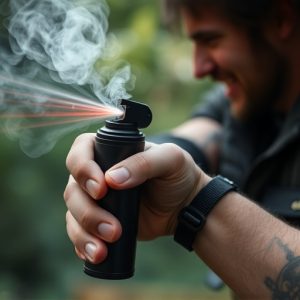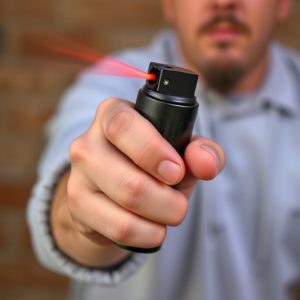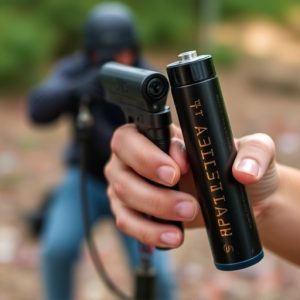Pepper Spray Gel vs Stream: Choosing Protection for Civilian Use
In civilian protection, both pepper spray gel and stream have distinct advantages. Gel's viscou…….
In civilian protection, both pepper spray gel and stream have distinct advantages. Gel's viscous nature provides prolonged protection against multiple attackers in close quarters, while stream offers a powerful jet for immediate disruption in open spaces. The choice depends on personal preference and situational needs: gel for close-quarters combat, stream for versatility.
In today’s world, self-defense is a crucial consideration for civilians. Among various options, pepper spray has emerged as a powerful tool, with two prominent forms: gel and stream. Understanding the key differences between these substances is essential for making informed decisions. This article delves into the unique properties of pepper spray gel and stream, exploring their civilian protection use cases, advantages, and disadvantages. By comparing Pepper Spray Gel Vs Stream, individuals can choose the right option to enhance personal safety.
- Understanding Pepper Spray Gel and Stream: Key Differences
- Civilian Protection Use Cases for Each Spray Type
- Advantages and Disadvantages of Pepper Spray Gel Vs Stream
- Choosing the Right Inflammatory Spray for Your Needs
Understanding Pepper Spray Gel and Stream: Key Differences
Pepper spray gel and stream are two distinct forms of self-defense tools, each with unique properties designed for different scenarios. Understanding their key differences is crucial when considering civilian protection. Pepper spray gel is a viscous substance that clings to targets, causing temporary blindness, coughing, and difficulty breathing. Its sticky consistency allows it to adhere to surfaces and remain effective even after the initial application, making it ideal for close-quarters combat or situations where suspects may try to wipe off the spray.
In contrast, pepper spray stream offers a more targeted approach. This form of spray is designed to create a narrow, powerful jet that can be directed at an assailant from a safe distance. Unlike gel, the stream dissipates quickly, making it less likely to stick to surfaces or clothing and causing immediate but temporary discomfort. This makes it a preferred option for self-defense in open spaces or when dealing with multiple attackers.
Civilian Protection Use Cases for Each Spray Type
Civilian protection is a growing concern for individuals seeking safe and effective self-defense options. In this context, pepper spray has emerged as a popular choice due to its non-lethal nature and ability to incapacitate an assailant temporarily. When considering civilian protection use cases, it’s essential to understand the distinctions between pepper spray gel and stream varieties.
Pepper spray gel offers a more concentrated and viscous formula, designed to stick to the target’s skin and eyes, causing severe irritation and discomfort. This makes it ideal for close-quarters combat or situations where the assailant is wearing protective gear. On the other hand, pepper spray streams provide a wider area of coverage, allowing users to defend themselves from a distance. It’s particularly useful in open spaces or when facing larger opponents, as the stream can quickly disable an aggressor without close contact. The choice between gel and stream depends on personal preference, situational awareness, and the specific threats an individual may face.
Advantages and Disadvantages of Pepper Spray Gel Vs Stream
Pepper spray gel and stream offer distinct advantages in civilian protection scenarios, each with its unique properties. One of the key benefits of pepper spray gel is its sticky consistency, which allows it to cling to attackers’ skin and eyes, providing a longer-lasting effect. This feature can be crucial in close-quarters combat or when dealing with multiple assailants. The gel formula also tends to cause more severe irritation, ensuring a quicker incapacitation.
On the other hand, stream spray offers greater reach and coverage. Its aerosol form enables users to target attackers from a distance, making it ideal for open spaces or situations where close contact is avoided. Unlike gel, stream spray dissipates quickly, which can be an advantage in well-ventilated areas as it reduces residual irritation. However, the shorter-acting nature of stream spray means it may not provide the same sustained protection against multiple attackers.
Choosing the Right Inflammatory Spray for Your Needs
When considering an inflammatory spray for civilian protection, understanding the difference between pepper spray gel and stream is key to choosing the right tool for your needs. Pepper spray gel is a more viscous substance that sticks to targets, causing pain and temporary blindness. It’s ideal for close-quarters combat and self-defense against multiple attackers due to its ability to remain adhered to clothing or skin.
In contrast, pepper spray stream offers a more concentrated but shorter-range blast of irritants. It’s perfect for creating distance between you and an assailant or temporarily disabling someone at a slightly farther range. The choice depends on your specific situations: if you often find yourself in close encounters where adherence of the gel is beneficial, or if you need a more versatile option for various scenarios.
In conclusion, both pepper spray gel and stream offer unique advantages in civilian protection scenarios. Understanding the key differences between these two types is essential when choosing the right tool for your needs. Pepper spray gel provides a more targeted and less windy approach, making it ideal for close-quarters combat. On the other hand, pepper spray stream offers greater range and coverage, suitable for open spaces or remote areas. By weighing the advantages and disadvantages of each, individuals can make an informed decision to ensure their safety and effectiveness in various civilian protection situations.


